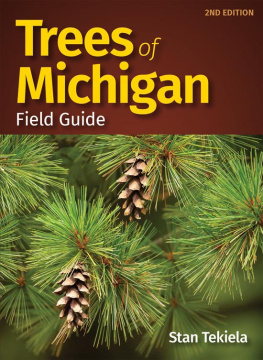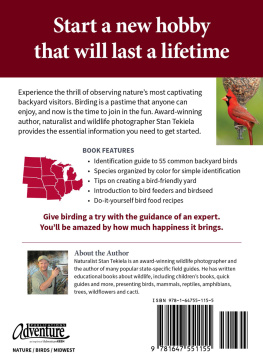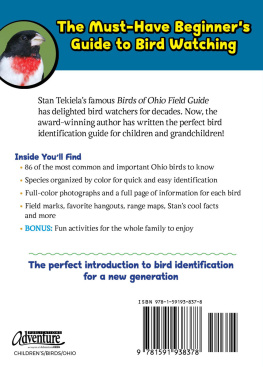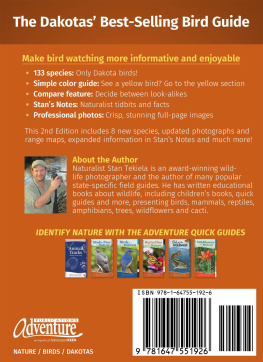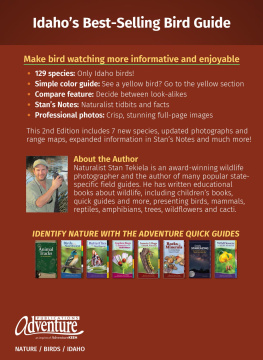

Edited by Sandy Livoti and Dan Downing
Cover, book design and illustrations by Jonathan Norberg
Range maps produced by Anthony Hertzel
Cover photo: Lazuli Bunting by Stan Tekiela
All photos by Stan Tekiela except (female) by Jim Zipp
To the best of the publishers knowledge, all photos were of live birds. Some were photographed in a controlled condition.
10 9 8 7 6 5 4 3 2 1
Birds of Colorado Field Guide
First Edition 2001
Second Edition 2021
Copyright 2001 and 2021 by Stan Tekiela
Published by Adventure Publications
An imprint of AdventureKEEN
310 Garfield Street South
Cambridge, Minnesota 55008
(800) 678-7006
www.adventurepublications.net
All rights reserved
Printed in China
ISBN 978-1-64755-082-0 (pbk.); ISBN 978-1-64755-083-7 (ebook)
TABLE OF CONTENTS
WHATS NEW?
It is hard to believe that its been more than 20 years since the debut of Birds of Colorado Field Guide. This critically acclaimed field guide has helped countless people identify and enjoy the birds that we love. Now, in this expanded second edition, Birds of Colorado Field Guide has many new and exciting changes and a fresh look, while retaining the same familiar, easy-to-use format.
To help you identify even more birds in Colorado, I have added 7 new species and more than 150 new color photographs. All of the range maps have been meticulously reviewed, and many updates have been made to reflect the ever-changing movements of the birds.
Everyones favorite section, Stans Notes, has been expanded to include even more natural history information. Compare sections have been updated to help ensure that you correctly identify your bird, and additional feeder information has been added to help with bird feeding. I hope you will enjoy this great new edition as you continue to learn about and appreciate our Colorado birds!

WHY WATCH BIRDS IN COLORADO?
Millions of people have discovered bird feeding. Its a simple and enjoyable way to bring the beauty of birds closer to your home. Watching birds at your feeder often leads to a lifetime pursuit of bird identification. The Birds of Colorado Field Guide is for those who want to identify common birds of Colorado.
There are over 1,100 species of birds found in North America. In Colorado alone there have been more than 460 different kinds of birds recorded through the years. These bird sightings were diligently recorded by hundreds of bird watchers and became part of the official state record. From these valuable records, Ive chosen 137 of the most common birds of Colorado to include in this field guide.
Bird watching, or birding, is one of the most popular activities in America. Its outstanding appeal in Colorado is due, in part, to an unusually rich and abundant birdlife. Why are there so many birds? One reason is open space. Colorado is more than 104,000 square miles (269,000 sq. km), making it the eighth-largest state.
Despite its size, only about 5.8 million people call Colorado home. On average, thats only 56 people per square mile (22 per sq. km). Most of these people are located in and around only four major cities, all of which line up in a narrow belt of about 200 miles (322 km) along the eastern foothills of the Rockies. Over 85 percent of the states population lives in an urban environment. This concentration of people leaves plenty of room for birds.
Open space is not the only reason there is such an abundance of birds. Its also the diversity of habitat. The state can be broken into three distinct habitatsplains, mountains and plateauseach of which supports a different group of birds.
The eastern one-third of the state is composed of a flat or gently rolling terrain known as the Great Plains. This region is home to many open country birds, such as the Lark Bunting, which is also the official state bird of Colorado.
Dividing the state down the middle is the southern extension of the Rocky Mountains. These mountains, with more than 50 peaks over 14,000 feet (4,250 m), are a great place to see alpine birds and more. Birds such as the Mountain Chickadee and Cassins Finch call this mountainous region home.
To the west of the Rockies lies the Colorado Plateau. This region stands between 5,000 and 11,000 feet (1,500 to 3,350 m). Its many hills and valleys are home to such birds as the Common Raven and Green-tailed Towhee.
Water also plays a part in Colorados bird populations. There are over 450 sq. miles (1160 sq. km) of water surface in the state. From the Colorado River to the Arkansas River, this essential element supports a wide variety of water-loving birds such as the American White Pelican and American Avocet.
Varying habitats in Colorado also mean variations in weather. Since elevation in the state rises from approximately 4,000 feet (1,200 m) in the eastern plains to over 14,000 feet (4,250 m) at mountaintops, there are great differences in weather. Tall peaks, such as Pikes Peak, Mount Evans and Blanca Peak, are some of the coldest and snowiest places in Colorado, while the Great Plains region is the beneficiary of warming air as it moves down from the high country.
In hot weather or cold, in elevations low or high and anywhere in between, there are birds in Colorado to watch in each season. Whether witnessing a migration of hawks in fall or welcoming back hummingbirds in spring, there is variety and excitement in birding as each season turns to the next.
OBSERVE WITH A STRATEGY;
TIPS FOR IDENTIFYING BIRDS
Identifying birds isnt as difficult as you might think. By simply following a few basic strategies, you can increase your chances of successfully identifying most birds that you see. One of the first and easiest things to do when you see a new bird is to note its color. This field guide is organized by color, so simply turn to the right color section to find it.
Next, note the size of the bird. A strategy to quickly estimate size is to compare different birds. Pick a small, a medium and a large bird. Select an American Robin as the medium bird. Measured from bill tip to tail tip, a robin is 10 inches (25 cm). Now select two other birds, one smaller and one larger. Good choices are a House Sparrow, at about 6 inches (15 cm), and an American Crow, around 18 inches (45 cm). When you see a species you dont know, you can now quickly ask yourself, Is it larger than a sparrow but smaller than a robin? When you look in your field guide to identify your bird, you would check the species that are roughly 610 inches (1525 cm). This will help to narrow your choices.
Next, note the size, shape and color of the bill. Is it long or short, thick or thin, pointed or blunt, curved or straight? Seedeating birds, such as Blue Grosbeaks, have bills that are thick and strong enough to crack even the toughest seeds. Birds that sip nectar, such as Black-chinned Hummingbirds, need long, thin bills to reach deep into flowers. Hawks and owls tear their prey with very sharp, curving bills. Sometimes, just noting the bill shape can help you decide whether the bird is a woodpecker, finch, grosbeak, blackbird or bird of prey.
Next, take a look around and note the habitat in which you see the bird. Is it wading in a saltwater marsh? Walking along a riverbank or on the beach? Soaring in the sky? Is it perched high in the trees or hopping along the forest floor? Because of diet and habitat preferences, youll often see robins hopping on the ground but not usually eating seeds at a feeder. Or youll see a Blue Jay sitting on a tree branch but not climbing headfirst down the trunk, like a Red-breasted Nuthatch would.
Next page



